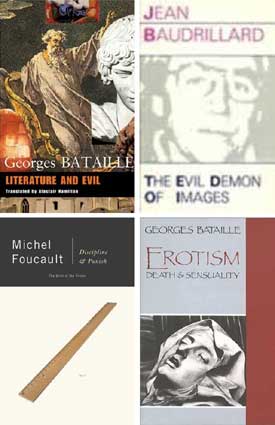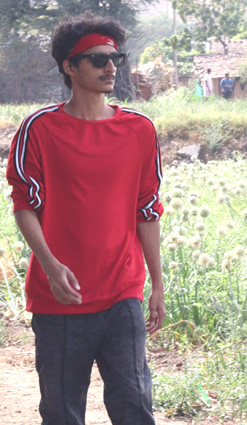A thirst for poetic transgression: annihilating the limits of cinematic romance
Transgression “perhaps is like a flash of lightning in the night which, from the beginning of time, gives a dense and black intensity to the night it denies, which lights up the night from the inside, from top to bottom, yet owes to the dark the stark clarity of its manifestation, its harrowing and poised singularity.”[1]
-Michael Foucault
Transgression has been both conceptually and as a praxis a topic of controversy and intense censorship. To question the necessity of both will be to demean the significance of transgression. Historically, it’s through transgressive ideas and actions that made the present reality a possibility. Ideas that may seem mad. “Madness is the absolute break with the work of art; it forms the constitutive moment of abolition, which dissolves in time the truth of the work of art.” [2]Although flawed, institutional and morally bankrupt, the idea of freedom that is today is possible due to said breaking of societal taboos – weather it be a revolution (Cultural, October, French) or to surpass or rather disrupt the public ally accepted morality — it is through these transgressions that we’ve reached a point in time and space where, if not action, thought is free. There are no ‘Thought Police’ yet. We may not be a fully operational Orwellian state yet. Perhaps if we give the ruling government another term, they may make that a possibility for their desire is to embody the most powerful form of authority. Transgression, like Madness, is at the heart of Art without which one would be devoid of great works of art that we celebrate to this date. Marquis de Sade, J. G. Ballard, Emily Bronte, Fredrich Nietzsche, William Burroughs, Goerges Bataille, Michel Foucault, Yukio Mishima and more have given far more than we credit them with. They engaged in taboos and acts restricted by the authority at the time and through this engagement they transcended to a realm of a pure form of natural instincts, intuition and desires that may, too this date, be forbidden. A man tortures his beloved mentally precisely because he loves her through which an intense form of hate and disgust is released and subjected on the woman. But instead of refusing to oblige and agitate against this oppression the women allow his acts of violence for she senses a deep desire of love and passion in the man which eventually kills her. Here the conception of Love and Hate become one as if there were never the opposites to begin with. Both love and hate become inseparable, an outburst of pure passion and desires that leads one to become more than just an immutable human trapped inside flesh that the body is. There’s a reason why people remember Layla-Majnun, Romeo and Juliet, Anarkali-Saleem, Heer-Ranjha for they seem immortals, non-human entities who broke the barrier of both life and death. Is not Love then nothing more than a thirst to destroy one’s soul to prove their love to their lover. As if a lover is Abraham, their lover Isaac, and to prove their love, instead of sacrificing their lover, they sacrifice themselves, inverting God’s command and thus becoming more than God. The great ‘Evil’ that transgressed — The ‘Real’ Original Sin, before the transgression of Adam and Eve.
When thought profoundly, it explains why Satanism has its origin in the demonstrations/agitation by peasants against the feudal lords and their adopted religion. For the peasants. Satan represented the great transgressor that become more than an obliging puppet, the first revolution was therefore of Satan’s against God. When does the line between Good and Evil blur when puts this spin on Satan’s rejection to bow down — why would he? Was he not an entity of its own? Did he not deserve the freedom of life which is the most natural form of life? Was not then Satan the first Slave who chose to be The Master?
“Only literature could reveal the process of breaking the law — without which the law would have no end — independently of the necessity to create order.”[3] I take it a step further to add Cinema in that context. These transgressions are necessities and in Indian Cinema, one does not have to look further than the three great works of Yash Chopra. Given how easy it is to manipulative images or rather, transform images into something that transcends logic and understanding, there is a thin line that exists where an image can either be the most realistic depiction of truth and passions or it can be nothing more than fascist. Or it can blend into one. As Baudrillard puts it, “It is precisely when it appears most truthful, most faithful and most in conformity to reality that the image is most diabolical — and our technical images, whether they be from photography, cinema or television, are in the overwhelming majority more ‘figurative’, ‘realist’, than all the images from the past cultures.” [4]

Sahil Khan
KES Shroff College of Arts & Commerce

Thinkers such as Foucault, Baudrillard and Bataille have altered the way I think of things around me, especially in the medium of arts, culture and history. Employing the concepts contained in their works, I analyze the films of Yash Chopra, the filmmaker who has inspired me to the greatest degree, whom I find to be one of the most fascinating in Hindi Cinema, and whom I see fit as a subject of inquiry in this context.
Compulsive Fixation—transgression in Chandni
Right after the Lata Mangeshkar and Vinod Rathod helmed ‘Mehbooba’, composed by Shiv-Hari and written by Anand Bakshi ends, Rohit (Rishi Kapoor) takes the titular character Chandni (Sridevi) to his flat where in a room, hundreds of images are plastered on the walls. These photos of Chandni herself, expressing, laughing, smiling, dancing and all sorts of liberating motions becomes non-liberating the moment we realize that Rohit took them without her consent as if surveilling him. Freedom becomes a mere figment of imagination, a concept devoid of any reality to it. Chandni seems oblivious at first, awestruck later. The closest structure to this is Bentham’s Panopticon where Chandni represents the Tower through which she gazes at each and every image (cell/prison), surveilling herself entrapped in chambers of photographs that are taken without her permission.
One feels a range of emotions for this signals a liberal act of transgression. This is rather terrifying. An act of power — ‘I may not control you but I certainly can and do control your image’. But at the same time, it’s an act of devotion perhaps greater than that of God for one bows to a symbol of God but Rohit lives in this realm of symbolism, surrounding himself of every reflection, shadow, trace and imageries of his lover. He may even sacrifice himself to prove his devotion which he does as he’s met with a fatal accident as soon as he showers Chandni with flowers from a helicopter that crashes. Showering of flowers, an act one does in the presence of God alone. It whisks admiration and compulsion into one. This devotion curses Rohit as on his revisit to the room post his accident, he is traumatized by the memories of what he once had — his lover and his self. Love becomes disgust, trauma, hate all the same arisen from the same conception that his lover is.

Transgressions are necessities, and in Indian Cinema, one does not have to look further than the three great works of Yash Chopra.
Hauntological Love—transgression in Lamhe
Vertigo gave us what i consider the most haunting form of love. Love with not a person but their image to a point where Scottie (John Ferguson) commands Judy (Kim Novak) to dress like Madeleine (Kim Novak) to recreate the embodiment of Madeleine, his lover/obsession (for the line is blurred) making a simulation that keeps him in denial of her death or for him, disappearance. But somehow, Lamhe (1991) transcends this and reaches all that is beyond haunting.
A man in unrequited love with an inexistent form confused to see another form that resembles, mimics his love and in return this resemblance is in love with not the man but his myth, mental image, a phantom. I don’t think there’s anything more profoundly terrifying than this concept. ‘I love you to death but I’m intensely terrified of your image’.After Pallavi’s (Sridevi) death, Virendra (Anil Kapoor) is confused and in an existential psychodrama when Pooja (Sridevi), Pallavi’s daughter, looks the same as Pallavi. He is in love with Pallavi’s phantom, for a phantom is all that she was to him given she was in love with another man and died — completing her love. In his state he treats Pooja rather violently at first, rejecting the sight of her itself but eventually he confessed his love to Pooja. Matter of transgression? Age. Pooja is half his age, younger even. A taboo that Chopra didn’t shy away from.
To dabble the matters of consent will be to struck my head with a hammer for nothing is more complex and convoluted than deciding the universal age of consent that all have to ‘comply’ — a matter discusses to this date. Skipping its legality and sciences I will touch upon the power dynamic at play in this matter.
Society is constructed, structured by people in authority and power plays a significant role in governing this. Age of consent too belongs to this category. An authority, legality, is enforced upon the children to behave, act and live a certain way. A manner of discipline which limits their natural freedom, institution and instincts. To control, discipline, surveil and hence groom a child is the highest, most ruthless and direct form of power which, unfortunately, is at work in every corner of the world in the face of schools, military, hospitals and prisons. What Yash Chopra does, without a socio-political enquiry, is break this limit and associate with a taboo in an oblivious but no doubt interesting, almost passionately manner that remains justifiably Evil. What then, is Unjustifiable Evil?
Morality of Violent Desires—transgression in Darr
Perhaps the most corrupt, immoral, violent and unjustifiably evil a romance received was with Chopra’s 1993 venture, Darr (1993). In order to not sound repetitive which, I must’ve unfortunately come off as, I will make this short and less mystifying.
Evil is required to transgress, break and exceed the norms and boundaries set by society. But when one acts upon their most violent impulses that lack any moral or rational justification, it becomes unjustifiable and rather harmful. Yash Chopra does this consciously in Darr. The psychosexual exploration of the Freudian nightmare that Rahul (Shah Rukh Khan) is who exhibits maternal deprivation – with the death of his mother that he still communicates to, trying to materialize his desires in the most grotesque ways and getting away from being caught while at the same time wishing to be caught by Sunil (Sunny Deol) for he wants his intense desires to come out in the grandest ways possible as then, he won’t have to hold in these impulses. Rahul lets his self-destructive passions take hold of him and acts upon it but he’s not someone that is to be sympathized with. Chopra makes sure that sympathy is annihilated in his case. Rather, it is admiration that he wants one to undergo and this admiration is to have a sense of guilt for we know almost all his actions are unjustifiable but perhaps it’s guilt that cancels out our admiration for him. His death isn’t satisfactory that one feels after a villainous tyrant is killed nor does one feel saddened by his demise. A strong form of disturbance and disbelief is felt, as if one never expected him to die. As if his violence, romantic in that, were of such magnitude that it transcended mortality itself. ‘He may be dead but I won’t be surprised if he wakes up to call his beloved again’. “Our only real pleasure is to squander our resources to no purpose, just as if a wound were bleeding away inside us; we always want to be sure of the uselessness or the ruinousness of our extravagance.”[5]
A seed that Chopra plants in Chandni, grows in Lamhe, reaches its limit in Darr and finally transcends by the climax where it implodes and becomes greater than the movies, its images and its characters itself. Romance is at the heart of Chopra’s Evil for even Rahul’s last words are cries for his Lover.
References:
- Foucault, Michael. Power: Essential Works, 1954-1984. 2000. Penguin Classics. Hurley, Robert (Translator), Faubion, James D. (Editor).
- Foucault, Michael. Discipline and Punish: The Birth of the Prison.1975, Gallimard, in French; and 1977, Pantheon Books, in English. Sheridan, Alan (Translator).
- Bataille, Georges. Literature and Evil. 1957, in French; and 1973, Calder & Boyars, in English. Hamilton, Alastair (Translator).
- Baudrillard, Jean. The Evil Demon of Images. 1986. The Power Institute of Fine Arts. Patton, Paul, and Foss, Paul (Translators).
- Bataille, Georges. Erotism: Death and Sensuality. 1957, Ballantine Books, in French; and 1986, City Lights Publishers, in English. Dalwood, Mary (Translator).
Sahil Khan
Student, KES Shroff College of Arts and Commerce, Mumbai.

Share Widely
